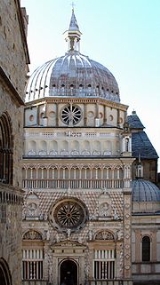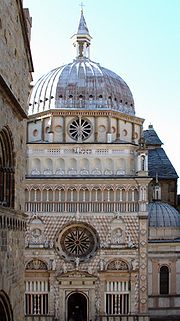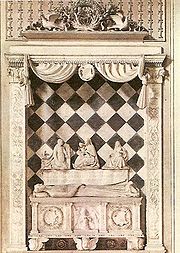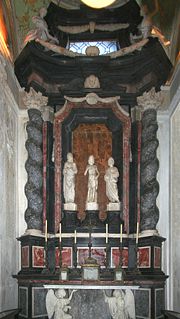
Cappella Colleoni
Encyclopedia

Bergamo
Bergamo is a town and comune in Lombardy, Italy, about 40 km northeast of Milan. The comune is home to over 120,000 inhabitants. It is served by the Orio al Serio Airport, which also serves the Province of Bergamo, and to a lesser extent the metropolitan area of Milan...
, northern Italy
Italy
Italy , officially the Italian Republic languages]] under the European Charter for Regional or Minority Languages. In each of these, Italy's official name is as follows:;;;;;;;;), is a unitary parliamentary republic in South-Central Europe. To the north it borders France, Switzerland, Austria and...
.
Dedicated to the saints Bartholomew, Mark and John the Baptist
John the Baptist
John the Baptist was an itinerant preacher and a major religious figure mentioned in the Canonical gospels. He is described in the Gospel of Luke as a relative of Jesus, who led a movement of baptism at the Jordan River...
, it was built in 1472-1476 as the personal shrine for the famous condottiere Bartolomeo Colleoni
Bartolomeo Colleoni
Bartolomeo Colleoni was a Venetian condottiero, who became Captain-General of the republic of Venice, where there is a famous statue showing him on horseback.-Biography:...
, a member of one of the most outstanding families of the city, and his beloved daughter Medea. The site chosen was that of the sacristy of the nearby church of Santa Maria Maggiore
Santa Maria Maggiore, Bergamo
The Basilica of Santa Maria Maggiore is a church in Bergamo, Northern Italy.-History:The church was founded in 1137 on the site of another church from the 8th century dedicated to St Mary, which had been in turn erected over a Roman temple of the Clemence. The high altar was consecrated in 1185 and...
, which was demolished by Colleoni's soldiers.
The design was entrusted to Giovanni Antonio Amadeo
Giovanni Antonio Amadeo
thumb|260px|The Colleoni Chapel in Bergamo.Giovanni Antonio Amadeo was an Italian early Renaissance sculptor, architect, and engineer....
, whose plan respected the style of the church, as can been seen from the octagonal tambour
Tambour
In classical architecture, a tambour is the inverted bell of the Corinthian capital around which are carved acanthus leaves for decoration....
of the dome and in the lantern cusp, as well as in the use of polychrome marbles.
Overview
The façade is characterized by the use of tarsia and polychrome marble decorations in white, red and black lozengeLozenge
A lozenge , often referred to as a diamond, is a form of rhombus. The definition of lozenge is not strictly fixed, and it is sometimes used simply as a synonym for rhombus. Most often, though, lozenge refers to a thin rhombus—a rhombus with acute angles of 45°...
s. Over the main portal is a rose window
Rose window
A Rose window is often used as a generic term applied to a circular window, but is especially used for those found in churches of the Gothic architectural style and being divided into segments by stone mullions and tracery...
, flanked by two medallions portraying Julius Caesar
Julius Caesar
Gaius Julius Caesar was a Roman general and statesman and a distinguished writer of Latin prose. He played a critical role in the gradual transformation of the Roman Republic into the Roman Empire....
and Trajan
Trajan
Trajan , was Roman Emperor from 98 to 117 AD. Born into a non-patrician family in the province of Hispania Baetica, in Spain Trajan rose to prominence during the reign of emperor Domitian. Serving as a legatus legionis in Hispania Tarraconensis, in Spain, in 89 Trajan supported the emperor against...
.
The upper part of the basement has nine plaques with reliefs of Biblical stories, and four bas-reliefs with Hercules
Hercules
Hercules is the Roman name for Greek demigod Heracles, son of Zeus , and the mortal Alcmene...
's deeds. The four pilasters of the windows flanking the portal are surmounted by statues of the Virtues. The upper part of the façade has a loggia
Loggia
Loggia is the name given to an architectural feature, originally of Minoan design. They are often a gallery or corridor at ground level, sometimes higher, on the facade of a building and open to the air on one side, where it is supported by columns or pierced openings in the wall...
in Romanesque style.

Nuremberg
Nuremberg[p] is a city in the German state of Bavaria, in the administrative region of Middle Franconia. Situated on the Pegnitz river and the Rhine–Main–Danube Canal, it is located about north of Munich and is Franconia's largest city. The population is 505,664...
in 1501. The whole complex is surrounded by a triumphal arch.
Amadeo himself executed the funerary monument of Medea Colleoni (died March 6, 1470). Located on the left wall, it has a statue of the Deposition from the Cross in high relief. The tomb was transferred here in 1892 from Urgnano
Urgnano
Urgnano is a comune in the Province of Bergamo in the Italian region of Lombardy, located about 45 km northeast of Milan and about 11 km south of Bergamo...
.
The presbytery has a high altar sculpted by Bartolomeo Manni in 1676, housing statues of the three saints to whom the chapel is dedicated, John, Mark and Bartholomew, by Pietro Lombardo
Pietro Lombardo
Pietro Lombardo was an Italian Renaissance sculptor and architect; born in Carona , he was the father of Tullio Lombardo and Antonio Lombardo....
. The upswept cornice is supported by Solomonic column
Solomonic column
The Solomonic column, also called Barley-sugar column, is a helical column, characterized by a spiraling twisting shaft like a corkscrew...
s. The altar table, to a design by Leopoldo Pollack, is supported by angels carved by Grazioso Rusca.


